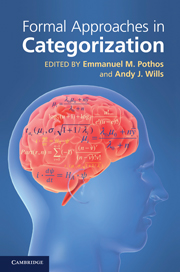Book contents
- Frontmatter
- Contents
- List of figures
- List of tables
- List of contributors
- 1 Introduction
- 2 The generalized context model: an exemplar model of classification
- 3 Prototype models of categorization: basic formulation, predictions, and limitations
- 4 COVIS
- 5 Semantics without categorization
- 6 Models of attentional learning
- 7 An elemental model of associative learning and memory
- 8 Nonparametric Bayesian models of categorization
- 9 The simplicity model of unsupervised categorization
- 10 Adaptive clustering models of categorization
- 11 Cobweb Models of Categorization and Probabilistic Concept Formation
- 12 The knowledge and resonance (KRES) model of category learning
- 13 The contribution (and drawbacks) of models to the study of concepts
- 14 Formal models of categorization: insights from cognitive neuroscience
- 15 Comments on models and categorization theories: the razor's edge
- Index
- References
12 - The knowledge and resonance (KRES) model of category learning
Published online by Cambridge University Press: 05 June 2012
- Frontmatter
- Contents
- List of figures
- List of tables
- List of contributors
- 1 Introduction
- 2 The generalized context model: an exemplar model of classification
- 3 Prototype models of categorization: basic formulation, predictions, and limitations
- 4 COVIS
- 5 Semantics without categorization
- 6 Models of attentional learning
- 7 An elemental model of associative learning and memory
- 8 Nonparametric Bayesian models of categorization
- 9 The simplicity model of unsupervised categorization
- 10 Adaptive clustering models of categorization
- 11 Cobweb Models of Categorization and Probabilistic Concept Formation
- 12 The knowledge and resonance (KRES) model of category learning
- 13 The contribution (and drawbacks) of models to the study of concepts
- 14 Formal models of categorization: insights from cognitive neuroscience
- 15 Comments on models and categorization theories: the razor's edge
- Index
- References
Summary
As this volume reflects, the dozens of models proposed to account for supervised category learning and classification over the last several decades differ from one another in multiple ways. One dimension of variation concerns activation dynamics. Under many sorts of theories, a stimulus is perceived, is compared to category representations, and is then (perhaps probabilistically) assigned to a category (Gluck & Bower, 1988; Kruschke, 1992; Love, Medin, & Gureckis, 2004; Medin & Schaffer, 1978). Much of the research in this framework explores the nature of the similarity processes that are used to compare stimuli to category representations.
Other lines of research have hinted that this sort of unidirectional flow of information from stimulus to category label may be inadequate to explain a number of phenomena. For example, Wisniewski and Medin (1994) found evidence for reinterpretation of ambiguous visual features based on prior conceptual knowledge. Thus, an alternative class of models views categorization as a constraint-satisfaction process, where representations of the stimulus and category representations interact to form an internally consistent representation (Goldstone & Medin, 1994; Rehder & Murphy, 2003). An assumption of interactivity is consistent with the many psychological systems that incorporate complex perceptual constraints at the earliest stages of processing (e.g., Balcetis & Dale, 2007; Friston, 2003; Spratling & Johnson, 2006; Tanenhaus et al., 1995).
A second dimension of variation concerns the nature of category representations.
- Type
- Chapter
- Information
- Formal Approaches in Categorization , pp. 274 - 298Publisher: Cambridge University PressPrint publication year: 2011

